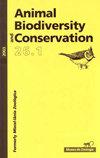Nestedness structure of bird assemblages in a fragmented forest in Central Argentina: the role of selective extinction and colonization processes
IF 1
4区 环境科学与生态学
Q3 BIODIVERSITY CONSERVATION
引用次数: 5
Abstract
Nestedness structure of bird assemblages in a fragmented forest in Central Argentina: the role of selective extinction and colonization processes. Nestedness analysis constitutes an important tool to understand the processes that shape wildlife communities. It also allows a quick first evaluation of species extinction proneness in fragmented landscapes. Here, we tested whether avian assemblages in the fragmented Espinal forest exhibited nested subset patterns. Furthermore, we examined whether selective extinction or selective colonization are driving nested subset patterns. We studied avian assemblages in 13 forest fragments in central Argentina during breeding and non–breeding seasons. We completed partial Spearman rank correlations to explore the relationship between nestedness rank order and habitat patch variables and species life history traits related to species extinction proneness and colonization rate. Bird species showed strong nestedness patterns, both for the total incidence matrix and for forest fragments and species separately. Nestedness patterns were similar during the breeding and non–breeding seasons. The nested rank order of forest fragments correlated with area and distance to nearest fragment, both of which are patch characteristics known to increase the probabilities of species extinction. The nested rank order of species was correlated with the minimum area of species requirement, trophic guild, and range size, traits that are linked to extinction risk. Selective extinction processes rather than selective colonization appear to be driving nestedness patterns of bird assemblages in fragmented Espinal forest. The most effective way to preserve forest bird species in the Espinal forest seems to be by protecting the larger fragments of this relictual forest.阿根廷中部破碎森林中鸟类组合的筑巢结构:选择性灭绝和殖民化过程的作用
阿根廷中部破碎森林中鸟类组合的筑巢结构:选择性灭绝和殖民化过程的作用。巢性分析是了解野生动物群落形成过程的重要工具。它还允许对破碎景观中的物种灭绝倾向进行快速的首次评估。在这里,我们测试了鸟类组合在破碎的埃斯皮纳尔森林中是否表现出嵌套的子集模式。此外,我们研究了是否选择性灭绝或选择性殖民化驱动嵌套子集模式。本文研究了阿根廷中部13个森林片段在繁殖期和非繁殖期的鸟类群落特征。通过部分Spearman秩相关分析,探讨巢性秩顺序与生境斑块变量、物种生活史特征与物种灭绝倾向和定植率之间的关系。无论在总关联矩阵上,还是在森林碎片和物种上,鸟类都表现出强烈的筑巢模式。巢型在繁殖期和非繁殖期相似。森林碎片的嵌套等级顺序与面积和与最近碎片的距离相关,这两者都是已知的增加物种灭绝概率的斑块特征。物种的筑巢等级顺序与物种所需的最小面积、营养行会和范围大小相关,这些特征与灭绝风险有关。在支离破碎的埃斯皮纳尔森林中,鸟类的筑巢模式似乎是由选择性灭绝过程而非选择性定植驱动的。保护埃斯皮纳尔森林鸟类最有效的方法似乎是保护这片宗教森林的大块区域。
本文章由计算机程序翻译,如有差异,请以英文原文为准。
求助全文
约1分钟内获得全文
求助全文
来源期刊

Animal Biodiversity and Conservation
农林科学-动物学
CiteScore
2.00
自引率
0.00%
发文量
21
审稿时长
>12 weeks
期刊介绍:
Animal Biodiversity and Conservation (antes Miscel·lània Zoològica) es una revista interdisciplinar, publicada desde 1958 por el Museu de Ciències Naturals de Barcelona. Incluye artículos de investigación empírica y teórica en todas las áreas de la zoología (sistemática, taxonomía, morfología, biogeografía, ecología, etología, fisiología y genética) procedentes de todas las regiones del mundo. La revista presta especial interés a los estudios que planteen un problema nuevo o introduzcan un tema nuevo, con hipòtesis y prediccions claras, y a los trabajos que de una manera u otra tengan relevancia en la biología de la conservación. No se publicaran artículos puramente descriptivos, o artículos faunísticos o corológicos en los que se describa la distribución en el espacio o en el tiempo de los organismes zoológicos.
 求助内容:
求助内容: 应助结果提醒方式:
应助结果提醒方式:


